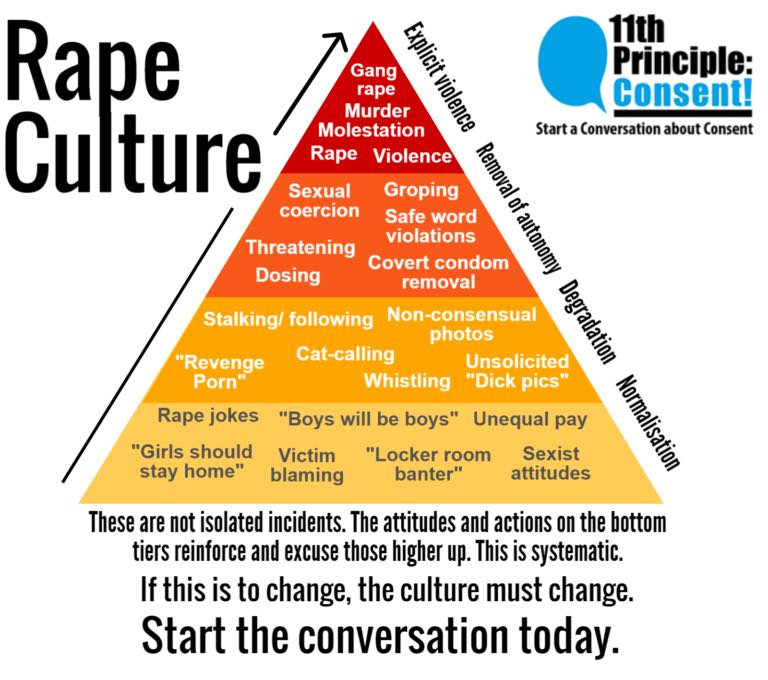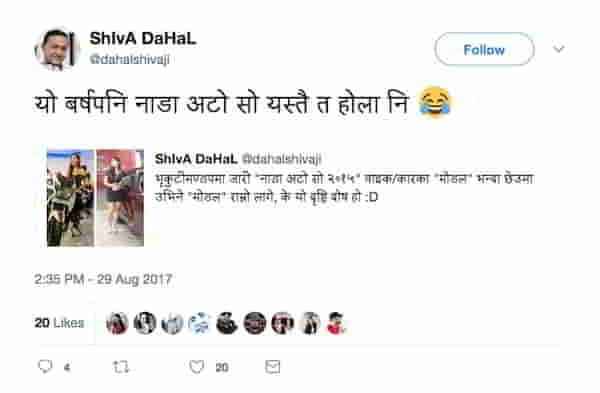Sadly, many might/probably see this as just a harmless joke. #GenderIssues #Kathmandu #Nepal pic.twitter.com/uBs8aKsTp3
— Dorje Gurung (@Dorje_sDooing) February 27, 2017
I came across the above promotion on Durbar Marg back on the 26th of February. Sadly, that kind of casual sexism is flagrant, rampant and accepted — i.e. the norm — in Nepal.
Of course, such casual sexism promotes, engenders, reinforces, perpetuates and supports the highly patriarchal and misogynistic society that we are.
Here’s just ONE example of what that kind of casual sexism, and our society’s misogyny, translates into in our daily lives.
Accompanied by a male friend, I had gone to an office in Kathmandu last winter to interview a man and a woman. The four of us were all seated around a wide rectangular table. My friend and I were on one side, across from the other two — he from the woman and I from the man.
Not surprisingly, the man started the conversation. He had started his life under really dire circumstances but, to make a long story short, he had managed to not only get a high school diploma but also an advanced degree — a master’s degree!
He talked and talked for about half-an-hour. From time to time I asked him a question here and a question there, as did my friend. Otherwise, of course, we listened, keenly, nodded etc. and basically gave him the respect he deserved as he spoke.
When he was done, I addressed the woman and through my body language — I faced her and looked her in the eyes etc. — I let her know that it was her turn to speak.
Incredibly, let alone do anything like what I had done, let alone pay attention to what she started saying, let alone feign interest in what she started saying, when she was into her second or third sentence my friend and the man started talking to each other!
I don’t remember which of the two started it but, of course, that’s besides the point.
Let me remind you — in case you have forgotten — that they were diagonally across just as the women and I were. I was listening to her and the only other two people in the room — both men — talked over her as if she did not even exist, as if they couldn’t hear a word of what she was saying!
I was gobsmacked!
I actually had to ask them to stop talking and listen to her, that it was her turn to speak and ours to listen.
Apart from just such flagrant disrespect to a woman, even by someone with a master’s degree, here are some other examples of the pernicious consequences of normalization of casual sexism: not all our girls and women are still able to walk the streets with their head held high, they are sexually harassed in public transportation and during festivals such as Holi (AND blamed for being victims), they are abysmally poorly represented in the power structure, and they are still treated as second class citizens by the State etc. All that, I am pretty certain, contributes to the fact that suicide is their biggest killer.
Here are some suicide data quoted in the article World Health Day: Growing suicide rates major cause for concern published on April 7, 2017, in The Kathmandu Post.
“In a statistical model developed by the World Health Organisation in 2012, Nepal was ranked seventh in the world with suicide rates at 25 per 100,000 heads.
“Data compiled by the Ministry of Health in 2008-09 showed that 20 people out of every 100,000 who took their own lives were women.”
Though the two data are from different sources and covers different time periods, it’s probably safe to conclude that female suicide rate in Nepal must be disproportionately and unacceptably higher than that of males.
And if that’s not bad enough, the article states that since the earthquake, the number of people thinking about suicide has gone up. I am willing to wager that, since girls and women in general suffer more from calamities — both natural and man made — the number of girls and women contemplating suicide must also be disproportionately higher now than before the earthquake.
Returning to the tweet about the cafe on Durbar Marg proudly proclaiming how cold a beer they serve…after taking the photo, I wondered where they must have gotten that from.
I came across the answer on Twitter: most likely a stubby holder similar to the following one! What’s more, this Nepali guy who tweeted the photo suggests one to “have fun” with the inherent casual sexism!
Sure, for @Iamotuppi this may all be about his stubby holder keeping his beer chilled just the way he — pretty sure @Iamotuppi is a he — wants, and the rest of the us also remaining “chill” about it! I, on the other hand, had no intention of staying so!
But before my response, here’s how the exchange actually started:
I tweeted the question, “And that makes it all right?!?!”
.@lamotuppi And that makes it all right?!?!
(US of) America has a narcissist for a president. Should we? @sazeenak
— Dorje Gurung (@Dorje_sDooing) March 16, 2017
But, not surprisingly, he missed the point, as you can see from his responses below.
With two more tweets, I tried to get across some of the consequences of that kind of flippant attitude towards casual sexism.
.@lamotuppi U r missing d big picture. That kind of attitude towards everyday misogyny likely props up our #PatriarchalSociety. @sazeenak + pic.twitter.com/Qbn4LBG1OV
— Dorje Gurung (@Dorje_sDooing) March 17, 2017
.@lamotuppi + & d kind of #PatriarchalSociety we have is 1 where SUICIDE is d biggest killer of females. https://t.co/vvqB8aPsuB@sazeenak
— Dorje Gurung (@Dorje_sDooing) March 17, 2017
He insisted on repeating his line again: “its [sic] just for fun[.]” What’s more, whereas I characterized that as casual sexism, he as “creativity.”
.@lamotuppi I rest my case! Go well! @sazeenakpic.twitter.com/0fCcVjs72s
— Dorje Gurung (@Dorje_sDooing) March 17, 2017
Browse newspapers, browse Twitter and Facebook — especially Facebook pages and groups by and for Nepalese boys and/or men — watch Nepali TV, Nepali movies and music videos, listen to music and radio programs, listen to conversation between boys and/or men in exclusive gatherings and you’ll see what I mean by casual sexism being rampant and normal in Nepal. The country, after all, is by men, for men…very insecure boys and men, yes very insecure boys and men!
I have argued just that in Nepal: No Country for Women. We, Nepali men (and boys), are indeed a pretty insecure lot when it comes to girls and women. The insecurity stems partly from our cluelessness, our lack of knowledge about them and about many of the issues they face. After all, our education system — both formal and informal — teaches us very little about sex, gender and gender issues.
I certainly did NOT learn much about that as a student at St. Xavier’s in the seventies and eighties. I am pretty certain lack of (gender) education was partly to blame for the young man with the master’s degree displaying such disrespect to her female colleague at the table.
But where we lack in education, us Nepali men make up for in arrogance and patriarchy! We rule, therefore, we believe we know what girls and women need, who and how they should be and why etc.
So, in addition to disrespecting them by ignoring them when they are speaking, we demean them in other ways, we write them off, and often do everything we can to control them — their bodies and their lives — etc. by establishing and following cultural and social norms, and religious practices that help us men do just that. In the process we stifle them, among other things, and in turn stifle our communities, our society and our country!
What do you think?
* * * * * * * *
References
The following were added two days after the publication of the blog post as further support to my argument, unless where noted otherwise.
- In the satirical blog post All for National Unity… Well Maybe Not… All!, I talk about a Nepali meme which describes examples of what people of different ethnicity are good at or do. Except, every single example in the meme is that of sons. If you didn’t know, you would think that in the Nepal the man — yes, pretty darn sure it was a man — he lives in has no women!! But of course, that’s NOT the explanation!
- “Tell Me, Where is Ethnicity-based Discrimination in Nepal?!” is another blog post where I tear apart the logic of the argument in yet another Nepali meme. Not surprisingly, in the Nepal the creator of this meme also lives, no woman exists, the meme features only sons, again!
- Note the choice of words in the headline of articles published by a national daily, My Republica, about our president — a woman president.
- I would be really impressed if this man and his belief is an exception in Nepal:
According 2 @bagale77 d reason inordinately more Nepalese men than women successful: their “steadfast struggles, hard-work, sacrifice” etc. pic.twitter.com/ysWw77GddN
— Dorje Gurung (@Dorje_sDooing) March 16, 2017
- It’s the normalization of casual sexism and treating girls and women as if they were less than us men, that victims of verbal and sexual harassment, such as Jemima, are forced to suffer in silence.
- This article (in Nepali) describes the findings of a study on the media reporting of gender-based violence in the country. It says that the study discovered reporting is nowhere near adequate and when reported, quality is suspect (it’s not victim-centered for example).
- [Added on May 24] I came across this image on social media (click here to go to the source) and realizing how it really REALLY neatly summarizes some of the points I make in the blog post, I decided to include it here. (The source also has a general consent flyers which you might find interesting and useful as well.)
- [Added on May 31] On Menstruation Hygiene Day, We Inspire Nepal posted an amazing photo album aimed at raising awareness about the the issues Nepalese girls and women face with and during menstruation because of our culture. Troll Nepal, a Facebook page with over half-a-million likes, posted a cringe-worthy and highly sexist response to it. (Click here to go to the actual post, or here for an image of it. The page also posted an equally cringe-worthy and logically flawed comment underneath.) Firstly, I am willing to bet that the administrator(s) of the page is a man (are all men)! Secondly, in addition to the reasons I have enumerated above for why we as a society is so misogynistic, it’s also the vacuous sense of self-importance which allows and even encourages Nepalese men to hold AND express such opinions publicly.
- [Added on Aug. 22, 2017] I don’t know how I forgot about this bathroom sign I saw way back in January, 2015, in Kathmandu. (The men’s bathroom has the text “Men Only” while the women’s contain an anthropomorphic character with a head of a tiger and wings on a semi-nude female body!)
- [Added on Aug. 31, 2017]. Shiva Dahal, the desk editor of Avenues TV, not content with just tweeting the sexist tweet in September 2015, he retweeted it recently.
 “The show must be the same this year too!”
“The show must be the same this year too!”And the original tweet reads: ‘If one finds the “model” better looking than the bike/car “model” she is standing next to at the “Nada Auto Show 2015” in Bhrikutimandap, is that one’s fault. :D’
Click here for the original tweet.Notice the number of likes the two tweets got! The replies in the original are embarrassing, especially those by the man himself.
- [Added on Sept. 12, 2017.] What these 4 women characters from Indian mythology tell us about rape culture.
- [Added on April 6, 2018.] This is about the gang rape of a 22-year old woman on January 25 (according to article in The Kathmandu Post) and January 21 (according to articles in The Himalayan Times) in Landmark Hotel on Durbar Marg by four men and everything surrounding the way our justice system failed her. It started with the officers for refusing the 22-year old victim’s charges, instead, telling the victim to settle the case with the perpetrators! What’s more, the police apparently arrested one of the rapists the very day after the incident, but was released a day later! The National Human Rights Commission had to form a panel to investigate the issue! Then reports appeared of the woman changing her statement, which, the police suspect, to be a result of intimidation. Police discovered the woman’s two bank accounts to have been credited with Rs 2.4 million and four lakh rupees! When the victim’s medical report came out, according to this article in The Himalayan Times, the police source made some outrageous claims! Namely: ‘A police source said, “The report says there is no clear evidence of gang rape.” “It also showed that the private part of woman appeared to be active before the alleged gang rape.”’ It would be the third week of March before the main culprit is finally arrested. He had allegedly paid off the victim’s mother as well as the two police officers of the Metropolitan Police Circle, Durbarmarg, with whom the woman had first attempted to register the charges! The other three are still at large! The April 6
- [Added on April 6, 2018.] The Kathmandu Post (April 6, 2018). Rape Culture. Their editorial which makes reference to the rape of the young woman in Landmark Hotel.
- Mahila Khabar (Female News). महिला मन्त्रालयको चरम लापरबाहीः प्रतिवेदनसँगै हरायो शीघ्र न्याय. This year. based on based on cases reported — I repeat, REPORTED — to the police, on average 34 women suffer from domestic violence DAILY! Given the stigma against BEING A VICTIM OF DOMESTIC VIOLENCE AND NOT A PERPETRATOR, I am willing to wager that, even by my very very conservative estimate, the actual number is at least 3X that! [Added Sept. 28, 2018.]
- The Kathmandu Post (Sept. 29, 2018). More women report domestic violence. “J had been married for 20 years, during which she was subjected to relentless domestic violence. She never got along with her mother-in-law and often had to endure her husband’s drunken behaviour.” […] “The findings of the women’s commission are similar to the findings of the most recent Nepal Demographic Health Survey, which showed that nearly a third of all married women in Nepal had experienced some kind of physical, emotional and sexual violence from their husbands.” [Added Oct. 2, 2018.]
- The Record (April 8, 2021). In upholding outdated gender norms, Nepali schools are failing their students. [Added April 14, 2021.]





